Computer Vision Statistics 2024 – By Segments, Countries, Artificial Intelligence (AI), Healthcare Market, Retail Industry, Surveillance, Symptoms
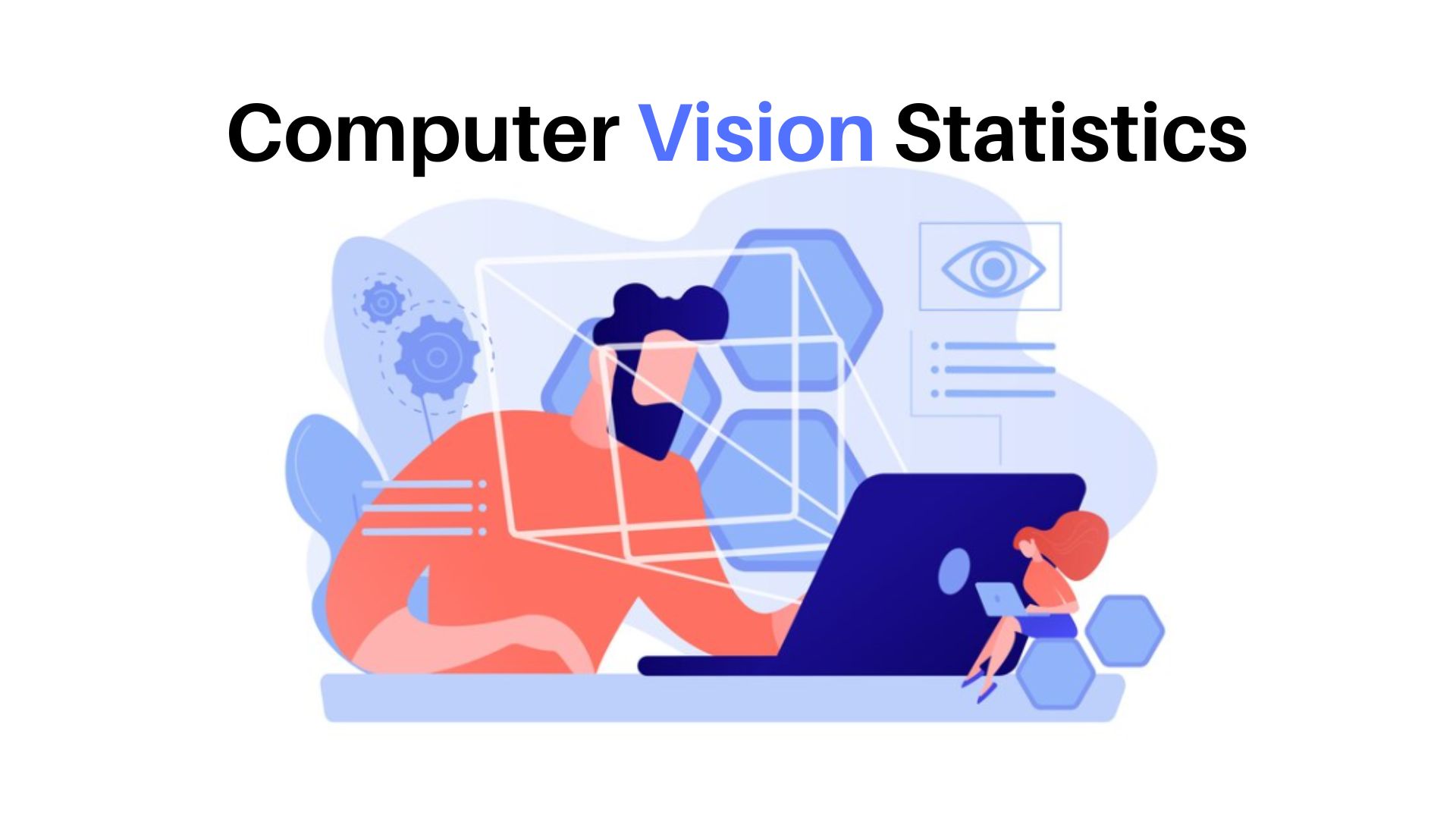
Page Contents
- Introduction
- Editor’s Choice
- Computer Vision Market Size And Forecast
- Trends in Computer Vision
- Computer Vision Statistics by Segments
- Computer Vision Statistics by Countries
- Computer Vision Statistics by Artificial Intelligence (AI)
- Computer Vision Statistics by Healthcare Market
- Computer Vision Statistics by the Retail Industry
- Statistics by the Manufacturing Industry
- Computer Vision Statistics by Surveillance
- Pros and Cons of Computer Vision
- Computer Vision Statistics by Symptoms
- Conclusion
Introduction
Computer Vision Statistics: According to reports, the market size of the Computer Vision industry is expected to grow to around 50.97 billion at the end of the year 2030. Computer vision is the concept that is based on Artificial Intelligence that allows computers to comprehend and interpret visual information from digital video and images, which is referred to as image recognition. Other examples include facial and speech recognition. This article contains a wealth of details on current computer vision trends, incorporating emerging technologies and their use across the globe.
Editor’s Choice
- According to Statista, the global market size of the Computer Vision market is going to be $22.27 billion by 2023. The compound annual growth rate (CAGR) of the industry is supposed to be 12.56% from 2023 to 2030.
- According to the analysis of Research and Markets, by the end of 2023, the market is predicted to grow by $14.95 billion with a CAGR of 11.2%, and by the end of 2027, it is going to be $23.06 billion with a CAGR of 11.4%.
- The United States has the largest market size of the computer vision market around the world with a market share of $5,306 million by the end of 2023.
- According to the research of AI Accelerator Institute as of 2023, the most used trend share is Generative AI (76%), Data-centric AI (11%), Merged reality (7%), and Facial recognition (6%).
- As of 2023, the Asia Pacific region is going to experience the largest market share, and North America is expected to be the fastest-growing region.
- According to the reports of Gitnux, by the end of 2025, the hardware and computer vision market is supposed to reach $48.6 billion.
- As of significant computer vision analysis potential by 2025, there will be more than 175 zettabytes of data available yearly.
- By the end of 2028, the surveillance security computer vision application is predicted to grow at a CAGR of 22%.
- On the other side, by 2026 the utilization of computer vision in autonomous vehicles is going to reach $55.67 billion at a CAGR of 39.47%.
- Furthermore, by 2024 the market of facial recognition within the computer vision industry is expected to be $7 billion.
- The face recognition market in 2023 is dominated by China which is followed by North America and Europe.
- The major players in the computer vision industries are Intel Corporation, National Instruments Corporation, SAS Institute, Keyence Corporation, and Texas Instruments Incorporated.
- Others are followed by Cognex Corporation, Baumer Holding AG, Omron Corporation, Sony Semiconductor Solutions Corporation, Matterport Inc., Teledyne Technologies Inc., Synopsys Inc., JAI, MediaTek Inc., Cadence Design Systems Inc., and CEVA Inc.
Computer Vision Market Size And Forecast
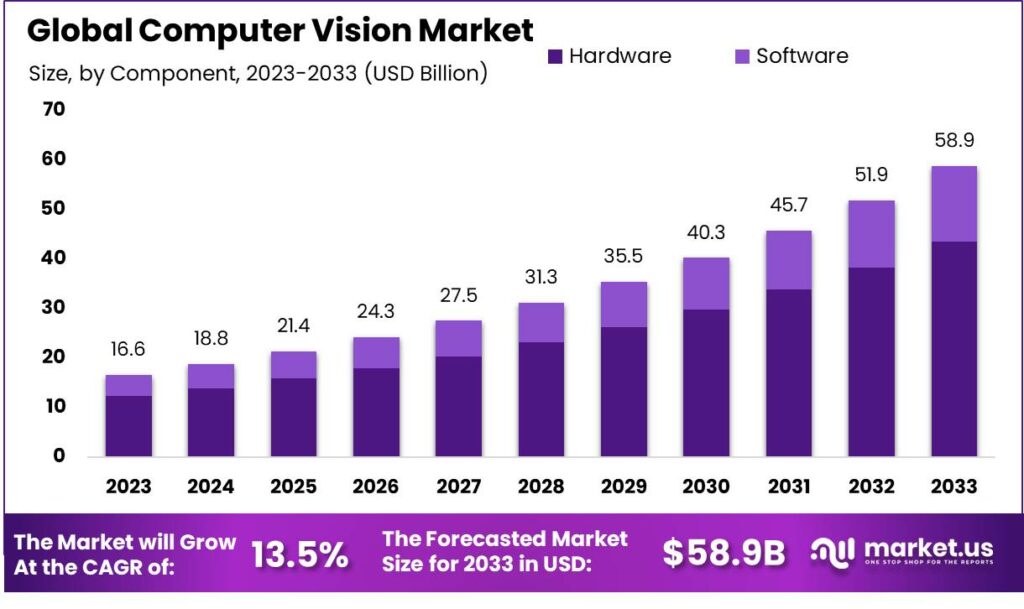
- According to Market.us, The Global Computer Vision Market is projected to reach approximately USD 58.9 billion by 2033.
- In 2023, this market was valued USD 16.6 billion.
- This growth represents a Compound Annual Growth Rate (CAGR) of 13.5%.
Trends in Computer Vision
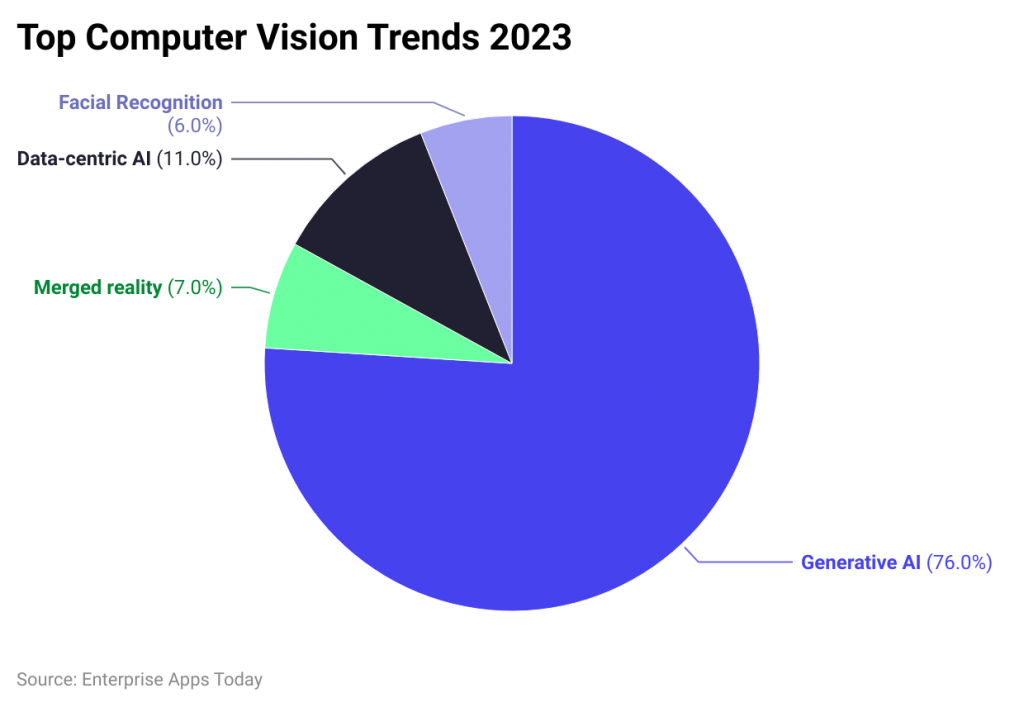
(Source: aiacceleratorinstitute.com)
- According to the research of AI Accelerator Institute as of 2023, the most used trend share is Generative AI (76%), Data-centric AI (11%), Merged reality (7%), and Facial recognition (6%).
- The topmost trend is Edge computing with efficient storage, faster processes, and cheaper. This context helps in making possible decisions along with analyzing real-time images.
- The important technology used in computer vision is 3D modeling which permits the development of digital models with real-world objects and locations.
- Data annotation is another trend that can improve work efficiency and accuracy within machine learning algorithms. This technology is used in several cars, scooters, toys, tools, etc.
- Furthermore, other trends of computer language processing for more user-friendly interfaces are natural language processing, model-centric to data-centric AI for enabling more effective and efficient machine learning, generative AI for more innovative and creative application usage, development of ‘metaverse’, medical imaging for enabling improved diagnosis and treatment, for enhancing security and safety facial recognition and surveillance is an effective trend.
Computer Vision Statistics by Segments
- The computer vision segment is divided into three sections facial recognition, image recognition, and speech recognition.
Facial Recognition
- According to Statista, in 2023 the global market size of facial recognition is going to reach $4.95 billion.
- By the end of 2030, the market size is expected to reach around $10.34 billion with a CAGR of 11.10% from 2023 to 2030.
- The largest market share resulted in $1,850 million in the United States by the end of 2023.
Image Recognition
- By the end of 2023, the global market size of image recognition is going to be $10.53 billion.
- As of 2030, the market size is expected to be around $21.07 billion with a CAGR of 10.42% from 2023 to 2030.
- The United States is going to achieve the largest market share resulting in $3,943 million in 2023 around the world.
Speech Recognition
- As of 2023, the worldwide market size of speech recognition is predicted almost $6.80 billion.
- In the year 2030, the expected market size is going to be $19.57 billion with a CAGR of 16.30% by the forecasted time.
- Around the world in 2023, the United States is going to achieve the largest market share with $2,512 million.
Computer Vision Statistics by Countries
In 2023, the market size for computer vision technology varied significantly across different countries. The United States led with a substantial market size of approximately $8.306 billion. Following the U.S., other countries exhibited varying market sizes:
- Algeria's market size reached $43.14 million.
- Argentina's market was valued at $30.87 million.
- Australia saw a market size of $458.60 million.
- Austria's market size stood at $141.50 million.
- Bangladesh nearly matched Australia with $458.48 million.
- Belgium had a market size of $174.70 million.
- Brazil's market reached $289.80 million.
In North America, Canada's market size was notably $0.58 billion. In contrast, Chile and Colombia had smaller markets at $58.32 million and $93.06 million, respectively. Notably, China demonstrated a significant market presence with $2.53 billion.
European countries showed diverse market sizes. For instance, Denmark's market size was $207.60 million, whereas the Dominican Republic was much lower at $20.86 million. Finland and France presented substantial market sizes of $196 million and $40.62 billion, respectively. Other notable European markets included Germany at $0.96 billion and Greece at $35.72 million.
Asian markets also varied widely. Hong Kong's market size stood at $161.90 million, while India's market was valued at $56.80 million. A significant market presence was seen in Japan with $0.87 billion and in South Korea with $411.70 million.
Other notable countries included Israel with a market size of $4142.70 million, Italy at $424.90 million, and the United Kingdom with a market size of $0.94 billion.
Computer Vision Statistics by Artificial Intelligence (AI)
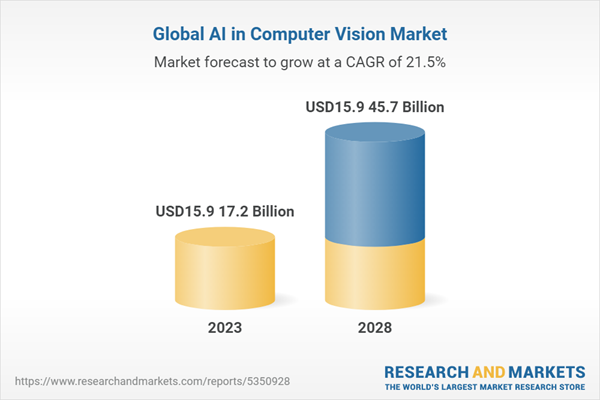
(Source: globenewswire.com)
- As per the above graph, it has been analyzed by the end of 2023 the global market size of AI in the computer vision industry is going to be $17.2 billion.
- In 2028, the expected market size of this industry is going to reach $45.7 billion at a CAGR of 21.5% from 2023 to 2028.
- As of 2023, Asia Pacific has experienced the largest share of the global market of AI in computer vision, whereas China has made huge investments in technologies for enhancing the market of computer vision.
Computer Vision Statistics by Healthcare Market
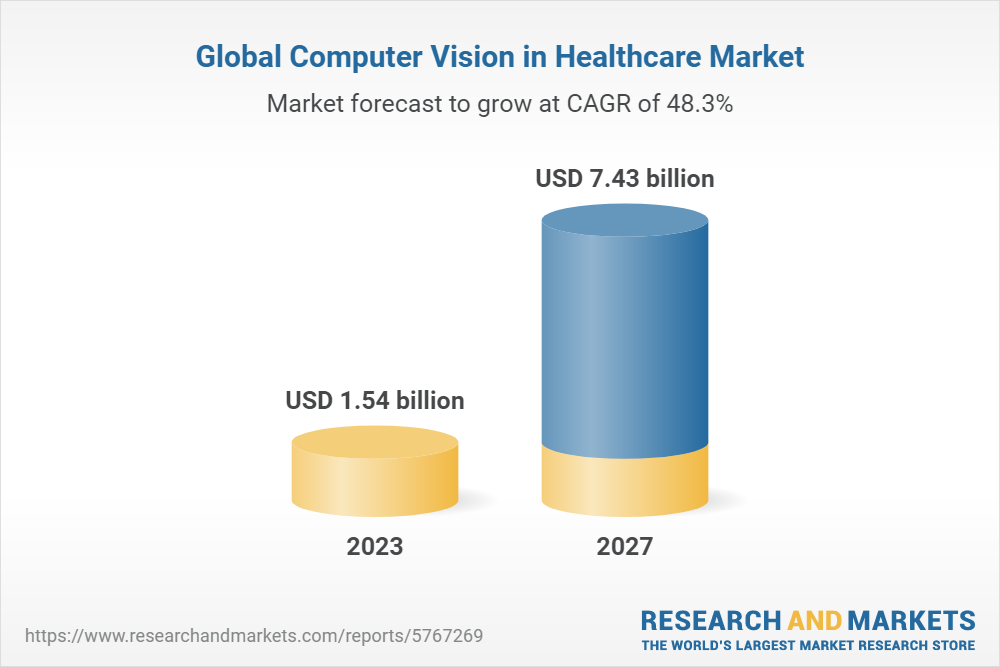
(Source: researchandmarkets.com)
- The global computer vision market of the healthcare industry in 2023 is expected to be $1.54 billion, and by the end of 2027, it is expected to be $7.43 billion with a CAGR of 48.3%.
- According to the end of Zipdo, by the end of 2025, the growth rate of computer vision technology in the healthcare industry is expected 47.3%.
- By 2030, computer vision in the healthcare industry is going to avert more than 20K deaths.
- Patient outcomes have improved by implementing computer vision which is agreed by 89% of healthcare professionals in 2023.
Computer Vision Statistics by the Retail Industry
- According to the research of Zipdo, by the end of 2025 computer vision retail market is expected to be $11.4 billion.
- As of 2023, after the implementation of computer vision in the food industry for controlling quality and product ID with <1% error.
- Currently, 44% of retailers are using AI technology that is Computer Vision for experiencing better customer experience.
- It is estimated that by the end of 2030, computer vision in the retail industry will gain 45% economic gains by a product enhancement.
- After the use of computer vision, 33% of retail customers have saved their wait time in the self-checkout process.
- By 2023, IBM has reported that the implementation of AI will grow at a CAGR of 48%.
Statistics by the Manufacturing Industry
- According to Voxel51, in the United States due to computer vision technology industrial automation is predicted to reach around $359 billion by the year 2029.
- It has also been estimated that the worldwide production of manufacturing will be above $40 trillion.
- After adopting Computer Vision, IoT, AI, and Robotics the manufacturing industry has gone through a massive transformation that is termed as 4th Industrial Revolution (4IR).
- Computer Vision applications that are used in manufacturing industries are bin picking, palletizing and de-palletizing, machine tending, defect detection, and predictive maintenance.
Computer Vision Statistics by Surveillance
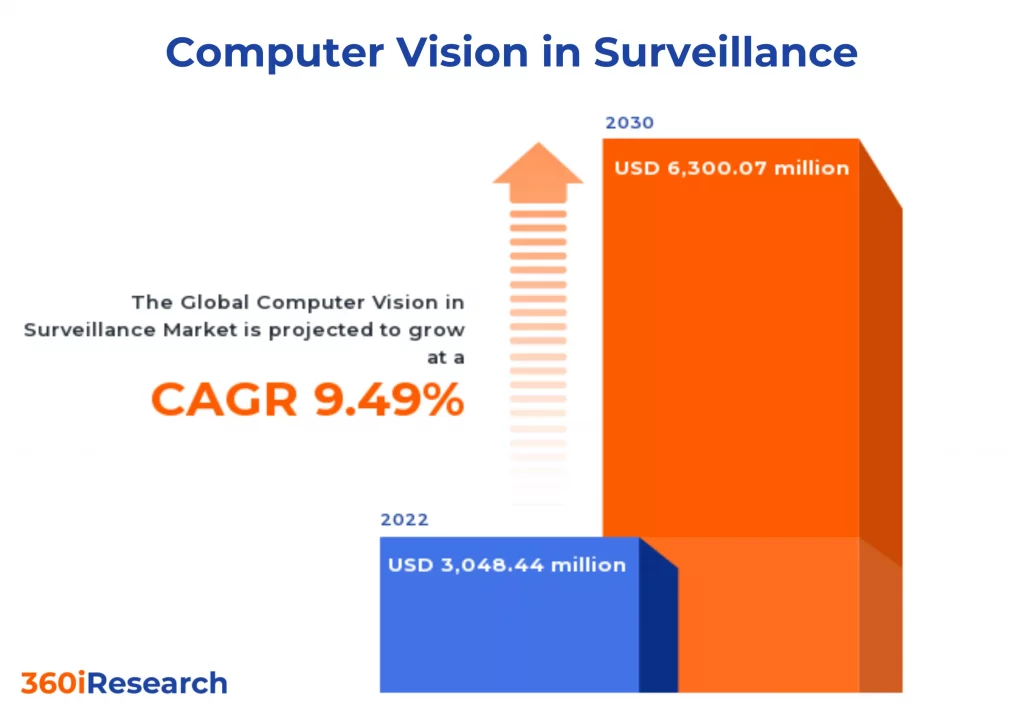
(Source:cloudfront.net)
- As of reports, the worldwide market size of surveillance in the computer vision industry by the end of 2023 is expected to be $3.33 billion, which has increased from last year.
- In 2023, the market size is expected to reach higher with a market value of $6.30 billion at a CAGR of 9.49% from 2023 to 2030.
- The product types of the surveillance market are PC-Based Vision and Smart Cameras-Based Vision.
Pros and Cons of Computer Vision
Advantages
- Computer vision makes the process much simpler and faster by enabling access to clients to check their products.
- Another advantage is reliability as cameras and computers don’t get tired as humans and do the work more efficiently along with eliminating other external factors.
- The precision accuracy of computer imaging allows for promoting better accuracy of the final result.
- Effective benefits also include less error rates, and less time consumption, and the cost of hiring and training staff has also been reduced.
- Other ranges of computer vision uses are tracking warehouses in factories, shipping of supplies, and scanning images in medical industries.
Disadvantages
- Machine learning and Artificial intelligence require effective specialists or professionals to maintain the overall system of computer vision.
- Another negative side is spoiling, as many times devices fail to understand the problem but humans can solve it more advance once it gets detected.
- Lastly, failing in image processing, and a lack of contextual understanding.
Computer Vision Statistics by Symptoms
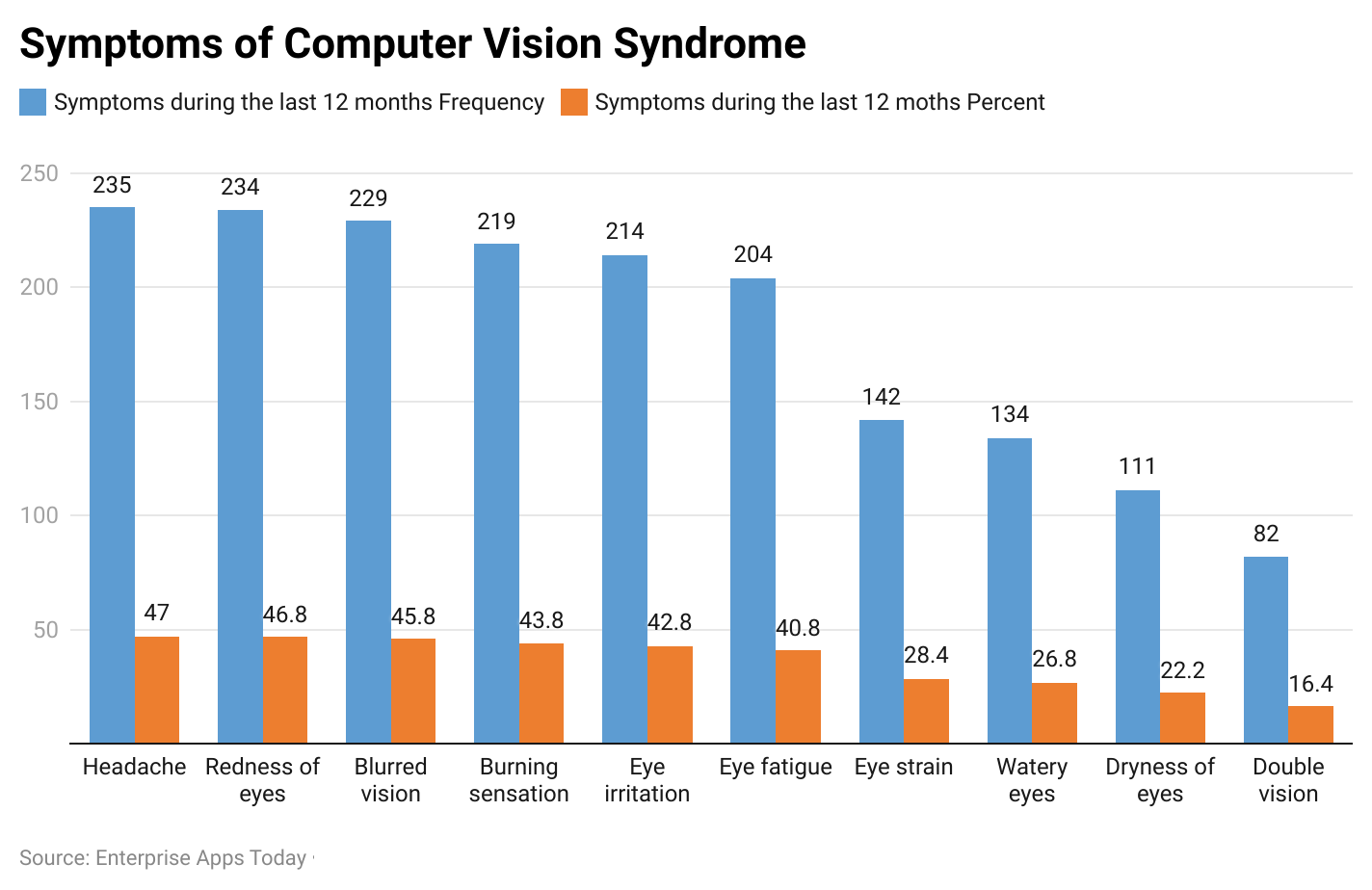
(Source: bioone.org)
Conclusion
As of today, after completing the article on Computer Vision Statistics it can be undoubtedly said that this is the fastest-growing and most powerful growing technology market in the world. This technology has many effective features that are already being used in several fields of our day-to-day life.
Computer Vision is a segment of Artificial and Machine Intelligence that allows for advanced recognition of facial, image, and speech which allow in enabling computers to identify and understand different people, objectives, and difficult scenarios. This article includes effective statistics, hope the above analysis will help in understanding the topic better.
Sources
FAQ.
The basic knowledge required for computer vision includes mathematics, calculus, linear Algebra, Data Science, programming languages such as Python, and Matlab, exceptional in C++ and other deep learning algorithms, and image analysis algorithms developing ability.
The 4 major problems in the computer visions are high costs, lack of professionals, need for regular monitoring, and size of required data sets.
There are several types of computer vision available facial recognition, image sensation, pattern detection, object detection, edge detection, image classification, and feature matching.
There are several tools used but some effective ones are OpenCV, Viso Suite, TensorFlow, CUDA, Matlab, Keras, etc.
For the first time computer Vision was invented by Larry Roberts who is a Ph.D. thesis (cir. 1960) from MIT.

Barry is a lover of everything technology. Figuring out how the software works and creating content to shed more light on the value it offers users is his favorite pastime. When not evaluating apps or programs, he's busy trying out new healthy recipes, doing yoga, meditating, or taking nature walks with his little one.